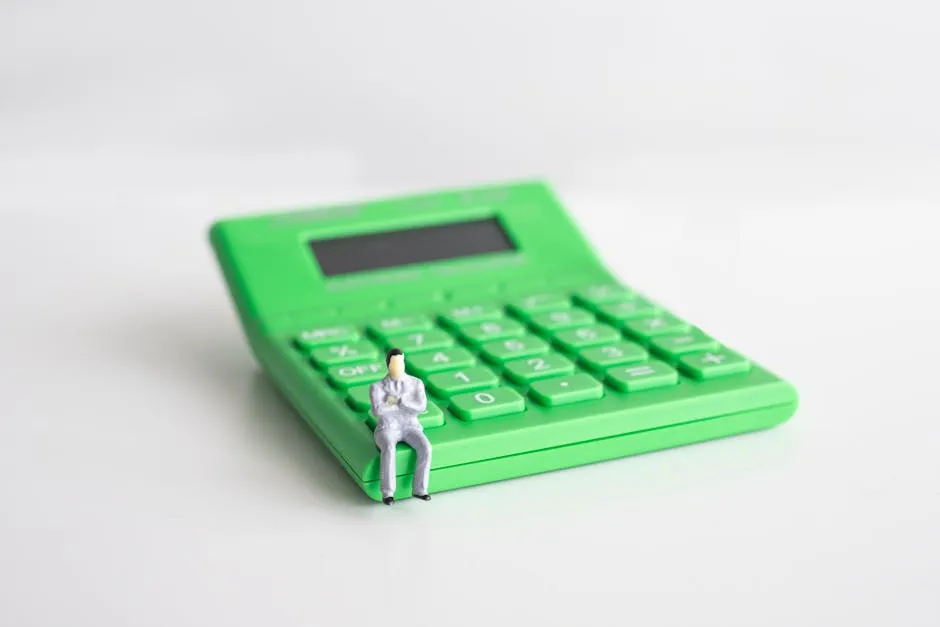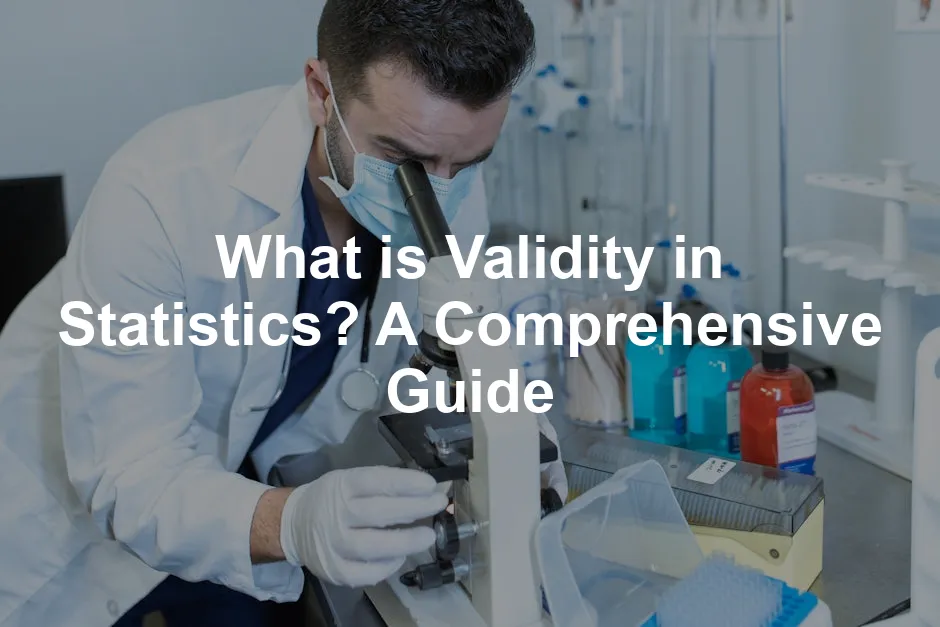Introduction
Validity in statistics is a vital concept. It refers to the degree to which a measurement accurately reflects the specific concept it aims to measure. Think of it as a tool’s ability to hit the target accurately. If your measuring tool can’t measure what it’s supposed to, then your results are as useful as a chocolate teapot!
In the realm of research and data analysis, validity is paramount. It ensures that researchers draw accurate conclusions from their data, leading to trustworthy insights. Without validity, interpretations can lead researchers down a rabbit hole of confusion, resulting in misguided decisions.
The purpose of this article is to provide a comprehensive guide on validity in statistics. You’ll learn the definition, its significance, and the various types of validity. By the end, you’ll have a solid understanding of how validity impacts research and data analysis, ensuring that you never mix apples with oranges again.
Before we dive in, having the right tools can make a huge difference in your research journey. Grab yourself a high-quality notebook for jotting down your brilliant insights, or maybe a set of colored pens for data visualization to make your notes pop! Trust me, your future self will thank you.

Understanding Validity in Statistics
Definition of Validity
Validity has its roots in the Latin word validus, meaning “strong.” This strength refers to the capability of a measurement to accurately capture the concept it intends to measure. For example, a depression scale should accurately reflect an individual’s depression levels, not just their mood swings after a bad cup of coffee.
It’s crucial to differentiate validity from reliability. While reliability measures the consistency of a measurement over time, validity checks if that measurement is indeed capturing the right construct. In simpler terms, a reliable measure can give you the same result repeatedly, but if it’s not valid, it might not be measuring the right thing at all.
Imagine using a very consistent ruler to measure the height of a dog, only to realize you were using a ruler meant for measuring fish. Consistent results? Sure! Accurate results? Absolutely not!

Importance of Validity
Validity is critical in research for several reasons. First, it ensures that the conclusions drawn from data are accurate. Without it, researchers risk making decisions based on flawed or misleading data. If your study’s findings lack validity, they could lead to misguided policies or ineffective interventions.
Moreover, validity has significant implications for statistical modeling and inferential statistics. When building models, the validity of the input measures directly impacts the reliability of the model’s predictions. A model based on invalid inputs is like trying to build a house on quicksand; it’s bound to collapse!
Speaking of models, if you’re looking to sharpen your statistical skills, consider picking up a copy of Statistics for Dummies. It’s a fun read that will demystify complex concepts and set you on the path to statistical enlightenment!

In summary, validity is more than just a buzzword in statistics. It’s a foundational pillar that supports the entire structure of research. Understanding and ensuring validity can make a world of difference in the accuracy and applicability of research outcomes. So, let’s dive deeper into the various types of validity in the next section!
Types of Validity in Statistics
Understanding validity is crucial in statistics, as it shapes the reliability of research outcomes. Let’s break down the various types of validity, starting with construct validity.
1. Construct Validity
Construct validity refers to how well a test or measurement aligns with theoretical concepts. In essence, it verifies that the tool measures what it intends to assess. If a tool claims to measure intelligence, then it should correlate with other established measures of intelligence. This type of validity is foundational in research as it integrates various other validity forms.

A. Convergent Validity
Convergent validity is a subset of construct validity. It confirms that measurements expected to be related are indeed correlated. For example, if a new IQ test correlates highly with a well-established IQ test, that’s convergent validity at work. It’s like having two friends who always agree on movie choices—you just know they’re on the same wavelength! This validation boosts confidence in the test’s effectiveness, ensuring it accurately captures the construct in question.
B. Divergent (Discriminant) Validity
On the flip side, we have divergent validity, which ensures that constructs that shouldn’t correlate do not. For instance, a measure of intelligence should show low correlation with a measure of unrelated traits, like physical strength. If your IQ test starts to resemble a measure of bicep size, we have a problem! Divergent validity helps distinguish different constructs, confirming that they stand apart and don’t overlap unnecessarily.

2. Content Validity
Next up is content validity. This form assesses whether the measurement tool covers all aspects of the concept being measured. Imagine trying to measure someone’s culinary skills solely by observing their ability to boil water. Sure, they can boil water, but can they whip up a five-course meal? Content validity ensures that all necessary dimensions are represented in the measurement.
To assess content validity, experts often evaluate the test items against the construct specifications. This can involve surveys or expert reviews to ensure comprehensive coverage. It’s like ensuring your shopping list includes all ingredients for a recipe; otherwise, you might end up with a half-baked dish!
And speaking of cooking, don’t forget to fuel those late-night study sessions with a coffee maker. Because what’s research without a little caffeine boost?

3. Face Validity
Face validity is more subjective but still incredibly important. It gauges whether a test seems relevant to the participants. Think of it as the “first impression” of validity. If a group of experts looks at a depression questionnaire and nods approvingly, it likely has good face validity. However, don’t be fooled—it doesn’t guarantee that the questionnaire measures depression accurately; it simply looks like it could.
The limitation of face validity is that it relies on subjective judgment. Just because something looks good on paper doesn’t mean it holds up in practice. For example, a questionnaire that asks about general happiness might seem valid for measuring depression, but it could miss crucial aspects. Thus, while face validity can be a good starting point, it should not be the sole basis for trusting a measurement tool.
To illustrate, consider a new emotional well-being app that promises to assess mental health through a few light-hearted questions. While it might seem fun and engaging (good face validity), it’s essential to evaluate whether it genuinely measures emotional well-being accurately.

In summary, validity is multifaceted and crucial for ensuring the accuracy of measurements in statistical research. By understanding the different types, researchers can better design studies and interpret results, leading to more reliable conclusions. After all, in the world of statistics, being valid is as important as having a sense of humor—both keep the data from going stale!
4. Criterion Validity
Criterion validity assesses how well one measure predicts an outcome based on another measure. It’s like having a reliable partner who can accurately predict your next move in a dance. There are two primary types: concurrent validity and predictive validity.

A. Concurrent Validity
Concurrent validity examines how well a new test correlates with a well-established test measuring the same construct. Imagine a new fitness tracker designed to measure heart rates. If it shows similar readings to a trusted heart rate monitor at the same time, it has good concurrent validity. This is crucial in fields like psychology and education, where new assessments need to align with existing, validated tools. In essence, it’s about making sure new kids on the block can keep up with the seasoned veterans!
B. Predictive Validity
Predictive validity, on the other hand, focuses on how well a test forecasts future outcomes. Think of it like a crystal ball—if a college entrance exam predicts students’ future academic success, it exhibits strong predictive validity. This type is particularly valuable in educational settings, employment assessments, and health diagnostics. A good example is the SAT, which aims to predict college performance. If test-takers achieve high grades later, the SAT’s predictive validity shines bright. After all, who wants a fortune teller that can’t get it right?

5. Internal Validity
Internal validity assesses whether a study accurately establishes a cause-and-effect relationship. It’s like a detective ensuring the evidence points to the right culprit. When researchers manipulate one variable, they must confirm that any observed changes in another variable result from that manipulation, not from outside influences.
However, several threats can undermine this validity. Confounding variables, which are outside factors affecting both the dependent and independent variables, can muddy the waters. For example, if a study examines the effect of a new teaching method on student performance but doesn’t account for prior knowledge, the results may be skewed. Ensuring internal validity is crucial, as it strengthens the credibility of the research findings.

6. External Validity
External validity evaluates how well research findings can be generalized to real-world settings. It’s the difference between a well-cooked dish in a test kitchen and what you serve at home. If your study’s results apply broadly to other populations, settings, or times, it has strong external validity.
Several factors can affect this validity. Sample representativeness is crucial; if your sample is too homogenous, your results may not apply to the general population. For instance, conducting a study on college students may not translate to the experiences of older adults. Additionally, environmental factors, like cultural contexts or economic conditions, can impact generalizability. Researchers must carefully consider these aspects to ensure their findings resonate beyond the lab.

7. Statistical Conclusion Validity
Statistical conclusion validity refers to the correctness of the inferences drawn from statistical analyses. It’s like ensuring your math homework is not just correct but also accurately reflects the problem at hand. This validity hinges on factors such as sample size and statistical power. A small sample size can lead to unreliable conclusions, akin to trying to predict a trend based on a handful of data points.
Furthermore, the choice of statistical tests plays a pivotal role. Using inappropriate tests can mislead researchers about relationships or effects, resulting in faulty conclusions. For example, applying a simple linear regression to a complex problem might overlook essential variables, leading to erroneous interpretations. Ensuring strong statistical conclusion validity is key to building reliable and replicable research outcomes.

Challenges in Establishing Validity
Common Issues
Validity is essential in research, but establishing it isn’t always a walk in the park. Researchers face several common hurdles that can trip up their quest for accuracy. One major issue is measurement error. This can occur when the tool used to collect data misfires, producing results that stray far from reality. Imagine trying to measure your height with a yardstick designed for measuring fish—accuracy is bound to swim away!
Biases also wreak havoc on validity. They can sneak into the research process like an uninvited guest at a party. For instance, selection bias occurs when the sample isn’t representative of the population. If you only survey gym-goers about exercise habits, you might miss the couch potatoes’ perspective. That’s like asking only bakers about the best cake recipe and ignoring the opinions of those who prefer savory pies!
Methodological flaws are another pitfall. Poor study design can lead researchers down a winding road with no clear destination. For instance, if a study lacks randomization, it may struggle to provide valid conclusions. This can result in false correlations or misleading findings. Think of it as trying to prove that eating cake makes you happy by only surveying birthday party attendees—cake might just be a cherry on top of a great day!
Lastly, inadequate knowledge of statistical techniques can undermine validity. If researchers wield the wrong statistical tools, they risk drawing inaccurate conclusions. It’s like trying to fix a car with a butter knife—good luck getting that engine running smoothly!

To avoid these pitfalls, consider investing in a scientific calculator to help you crunch those numbers accurately, or grab a digital voice recorder for capturing interviews and notes seamlessly. Just think of the time you’ll save!
Practical Solutions
So, how can researchers navigate these treacherous waters? Here are some practical tips to boost validity in research.
First, ensure that measurement tools are properly calibrated and tested. Regular maintenance on instruments can help minimize measurement errors. Imagine a scale that’s always accurate—now that’s a weighty advantage!
Next, prioritize representative sampling. Use random selection methods to ensure diverse participant representation. This is akin to mixing all the colors to create a masterpiece, rather than sticking with just one shade!
Consider employing blinding techniques in study designs. This helps reduce biases by preventing participants and researchers from knowing which group they belong to. It’s like setting up a surprise party—no one should know what’s happening until the big reveal!
Additionally, invest time in refining methodology. A well-structured research design should include clear operational definitions for variables. This clarity helps ensure that everyone is on the same page. After all, a shared understanding can prevent miscommunication—like making sure everyone knows that “spicy” means different things to different people!
Finally, educate researchers on statistical methods. Training and workshops can enhance their understanding of appropriate analyses. Knowledge is power, and in this case, it can lead to stronger conclusions. Just as a well-informed chef can whip up a culinary delight, a well-trained researcher can create robust findings.

Trends and Advances in Validity Assessment
New Methodologies
In the evolving landscape of research, new methodologies are sprouting like mushrooms after rain. Recent trends in validity assessment focus on innovative approaches to enhance measurement accuracy. For instance, many researchers are now leveraging machine learning algorithms to detect patterns that traditional methods might overlook. These algorithms can sift through vast data sets, identifying subtle relationships and improving overall validity. It’s like having a super-sleuth on your research team!
Moreover, advancements in technology are revolutionizing how we assess validity. Software tools that automate data collection and analysis are becoming increasingly popular. These tools minimize human error and biases, ensuring a more objective approach to validity assessment. It’s akin to having a trusty sidekick that never miscalculates!
Additionally, the rise of big data is reshaping validity assessment. Researchers are harnessing large datasets to validate findings across diverse populations. This broadens the scope of conclusions and enhances external validity. Imagine having a treasure chest filled with insights from countless studies—it’s hard to argue against a wealth of evidence!
Furthermore, a focus on mixed-methods approaches is gaining traction. Combining qualitative and quantitative methods can provide a more comprehensive understanding of validity. This holistic approach captures the nuances of human experiences while grounding findings in statistical rigor. It’s like adding both spice and sweet to your favorite dish for a balanced flavor!
Lastly, the emphasis on transparency in research is essential. Sharing methodologies and data openly fosters collaboration and scrutiny, helping to ensure that findings are valid and reproducible. This culture of openness is akin to inviting everyone into the kitchen to see how the magic happens. After all, who wouldn’t want a front-row seat to the recipe for success?

Conclusion
In wrapping up our exploration of validity in statistics, we’ve uncovered its multifaceted nature. Validity is all about ensuring that measurements accurately reflect what they claim to measure. We learned how it plays a crucial role in research, helping to draw genuine conclusions from data, leading to reliable insights. Remember, without validity, your research could lead you astray—like trying to navigate with a map that’s upside down!
We discussed various types of validity, including construct, content, face, criterion, internal, external, and statistical conclusion validity. Each type contributes to the overall strength of research findings. A study with solid validity can stand tall against skepticism, while one lacking it may crumble faster than a poorly constructed sandcastle.
So, as you embark on your own statistical adventures, keep validity at the forefront of your mind. It’s the backbone of credible research outcomes, ensuring your findings can genuinely inform decisions and policies. Validity is not just another academic term; it’s the guardian of truth in your data. Embrace it, and your research will shine brighter than a diamond in a coal mine!
FAQs
What is the difference between validity and reliability?
Validity and reliability are two peas in a statistical pod, but they serve different purposes. Validity measures how accurately a tool assesses what it’s supposed to measure. Think of it as the “does this test measure what it claims to?” question. For instance, if a math test inadvertently assesses reading skills, its validity is questionable. Reliability, on the other hand, is all about consistency. A reliable test yields the same results upon repeated trials. Imagine a clock that’s stuck at 3 PM—it’s reliable but not valid! In short, a test can be reliable without being valid, but it can’t be valid if it’s not reliable.
How can I improve the validity of my research?
Improving validity is crucial for robust research. Here are some actionable strategies: 1. Clearly Define Constructs: Make sure your constructs are well-defined. This helps ensure that your measurement tools align with what you intend to assess. 2. Use Established Instruments: Whenever possible, use measurement tools that have been validated in previous research. They’ve already passed the validity test! 3. Pilot Testing: Conduct pilot tests to identify any issues with your measurement tools before the actual study. It’s like a dress rehearsal for your research! 4. Diverse Sample: Ensure your sample is representative of the population to which you want to generalize your findings. A diverse sample leads to broader applicability. 5. Blinding Techniques: Use blinding in your study design to reduce biases that could affect validity. It’s like wearing blindfolds to keep your judgment fair! 6. Statistical Techniques: Employ appropriate statistical methods to analyze your data, ensuring that your conclusions are justified.
What are some common methods to assess validity?
Assessing validity involves several methods, each tailored to different types of validity: 1. Face Validity: Experts review whether a test appears to measure what it claims. It’s a first glance, not a deep dive! 2. Content Validity: Evaluators assess whether the test covers all relevant aspects of the construct. Think of it as checking if all ingredients are in a recipe. 3. Construct Validity: This can be tested through convergent and divergent validity. Convergent tests whether related constructs correlate, while divergent checks that unrelated constructs do not. 4. Criterion Validity: This involves comparing test results with an established criterion. It can be further divided into concurrent and predictive validity. 5. Statistical Analysis: Methods like regression analysis and factor analysis can help validate whether the data supports your hypotheses.
Can a test be reliable but not valid?
Absolutely! A test can be reliable (providing consistent results) but not valid (not measuring what it claims). For instance, consider a scale that consistently reads 5 pounds heavier than the actual weight. It produces reliable data, but it’s not valid because it doesn’t correctly measure weight. In essence, reliability is like a loyal friend who gives you the same advice every time, but it might not always be the best advice!
How does sample size affect validity?
Sample size plays a pivotal role in determining validity. A larger sample size generally increases the likelihood that your findings can be generalized to the broader population. It reduces the margin of error, enhancing statistical power, which helps in detecting true effects. Conversely, a small sample size can lead to misleading conclusions. It may cause random variations to skew results, making them less reliable. It’s like trying to predict weather patterns based on just a week’s worth of data—hardly a solid forecast! Thus, ensuring an adequate sample size is key to maintaining the integrity of your study’s validity.
Please let us know what you think about our content by leaving a comment down below!
Thank you for reading till here 🙂
For a deeper understanding of how statistical methods apply in various fields, check out this comprehensive guide on statistical methods for finance professionals 2024.
All images from Pexels




